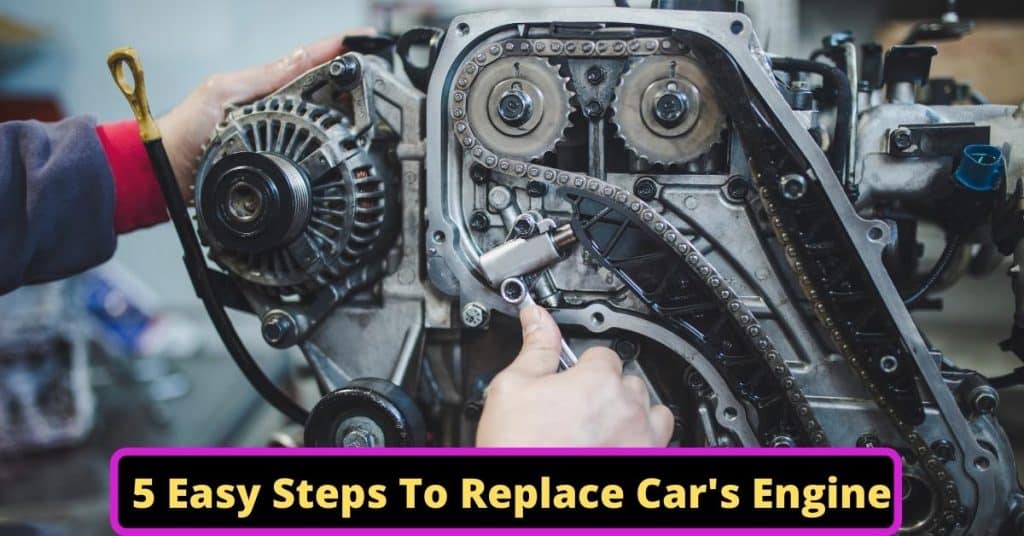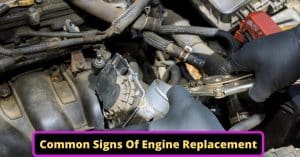What does a car engine replacement include?
Replacing an engine is not as simple as pulling out the old engine and slotting in a new one. In fact, it can be a pretty complex process that requires some specialized knowledge and equipment. The age of your car can impact which type of engine we can install, so you may need car engine replacement before or during the installation. For example, a newer model might require different fittings than an older model.
New and recent cars will be fitted with a brand new engine straight from the factory. However, older models are usually given engines from other cars that need to be replaced – either because they’re worn out or no longer available. We also offer refurbished engines from the same model year as your car, which have been completely rebuilt and tested for quality assurance purposes.
How long does it take to remove and replace an engine?
When it comes to car repairs, engine replacements are one of the more difficult tasks a person can take on. It’s a big job that usually takes around 10-12 hours to complete, and there are many things that can go wrong. Here we will outline the typical process for car engine replacement, as well as some tips to make the process easier.
First, you’ll need to find a reputable mechanic or shop that is familiar with your specific make and model of car. They will be able to help you measure where all the motor mounts and transmission mounts are on both vehicles–this is necessary in order to determine if they are compatible. You may also need other upgrades or parts depending on your car’s age and condition.
The average car engine replacement will take 10-12 hours to complete. This typically includes: checking the mounts for wear, repairing components, and installing new engines with accessories, spark plugs, sensors, and more.
While most shops will replace an engine for a price, it might cost more at certain shops depending on what you’re getting replaced with. Be prepared for potential issues like needing a new transmission, drivetrain upgrades, or the motor not fitting in your old car.
The average customer spends 75% of the time waiting for a tow truck, with the remainder of their time spent in various stages of the removal and replacement process on average. To determine if they are compatible, you need to measure where all the mount points are on both vehicles.
5 Easy Steps To Replace Car’s Engine
Replacing your car’s engine may seem like a daunting task, but it can be done with a little know-how and the right tools. Here are five easy steps to follow:
1) Purchase a new engine from the nearest auto shop.
2) Remove your old engine, and install the new one in its place.
3) Reattach all of the connections and hoses that were disconnected.
4) Fill up your engine with the appropriate type of fuel, or install a new one if you are replacing it.
5) Test the engine to make sure it works properly.
This guide provides helpful tips for those looking to replace their car’s engine on their own from finding the right company to getting an o-scope if needed. Follow these steps and you’ll be up and running in no time!
5 Things to Consider Before Swapping an Engine
Wiring
When doing an engine swap, it is important to understand the wiring. Wiring can be very complex, especially in a swap. The electric fan circuit requires two wires (power and ground) and one relay, but other circuits require relays as well.
It’s important to research this before doing an engine swap so that you know what you’ll need to connect. New model vehicles have far more wiring than previous models, so it’s important to research the compatibility of components and wiring before making this decision.
Cooling Systems
Cooling systems are important, but many people just underestimate the work that goes into them. The main purpose of a cooling system is to keep the engine from overheating by drawing heat away from it. This is done by circulating coolant through the engine and radiator. In order to do this effectively, you need a good cooling system with plenty of coolants.
One problem with cooling systems is that they can be easily damaged if not properly maintained. A ruptured radiator hose, for example, can cause the coolant to leak out onto the ground. If this happens while you’re driving, your car will overheat quickly and may even catch on fire.
Another issue with cooling systems is that they require regular maintenance in order to function properly. You need to make sure the hoses and fittings are tight, and that there’s enough coolant in the system at all times. If there isn’t enough coolant, your engine will overheat very quickly.
Mechanical fans should be used in older engines, but modern engines require more cooling than ever before. A mechanical fan uses power from the engine itself to turn the blades; this can slow down your car when you don’t want it to. An electric fan, on the other hand, is powered by the car’s electrical system and does not affect performance.
When one part of the engine fails, the rest can soon follow and cause more damage. For this reason, it’s important to have a good cooling system in place so that the engine can stay cool under all conditions. If an engine is physically damaged, it will not be a viable option for repair.
Headers
When fabricating headers from scratch, the tubing can hit something on the car and require another redesign. If this happens, it’s important to have a plan for what needs to be done so you’re not stuck with a part you can’t use.
It is also important to consider how the header will fit into the engine bay. Sometimes modifications need to be made to the firewall or other parts of the car in order for everything to fit properly.
Header installation can be tricky, especially if you’re not familiar with how they work. It’s important to take your time and make sure everything is installed correctly so there are no problems down the road.
Oil Pans and Pick-Up Tubes
When swapping an engine, you’ll need to replace the oil pan and pick-up tube. The stock oil pan will not clear the new engine’s headers. To avoid clearance issues, you’ll need to find an aftermarket oil pan.
Many custom oil pans are made from aluminium and can be fabricated with a CNC machine. However, people usually don’t have to do much work to make a custom oil pan and pick-up tube. All you may need is a tubing bender and some basic hand tools.
Fuel Systems
When it comes to swapping out an engine, one of the most important aspects of the car to consider is the fuel system. The three main components of a fuel system are:
The tank – This stores the fuel until it’s needed by the engine.
The pump – This draws the fuel from the tank and sends it to the engine.
The filter – This removes any contaminants from the fuel before it reaches the engine.
Common Signs Of Engine Replacement
Smoke
If you see smoke coming from your car, it’s a sign that the engine needs to be replaced. Smoke coming from both the hood and exhaust can be indicative of a car engine replacement.
In some cases, steering rack replacement is also a sign that the engine needs to be replaced. The engine light may indicate an issue with the steering rack. Other signs of failure include knocking, backfiring, hissing noises, and smoke from the tailpipe.
Engine replacement is a sign that your car needs to be serviced. You can contact an NRMA Mobile mechanic for help with maintenance and servicing.
Strange Noises
Knocking noises are one of the most common signs that an engine needs to be replaced. This is caused by engine bearing separation and should be taken care of by an auto body shop as soon as possible. Another sign of car engine replacement is the engine light on the dashboard. Steering rack replacement can also cause this light to come on.
Other signs include loss of power, fuel efficiency, noises including knocking and spitting, stalling, unusual smells, and excessive exhaust smoke.
High Fuel Consumption
If you’re experiencing high fuel consumption, it could be a sign that your engine needs to be replaced. Other signs that an engine might need to be replaced are if you’re losing mileage and detecting an oil-water mixture in the fuel tank. You might also notice that your gas gauge isn’t as accurate or you’re filling up more often than normal.
Another indicator of a worn-out engine is if your car isn’t performing as well as it used to. This could manifest itself in lower MPG, hesitation when starting off or strange noises coming from the engine compartment.
Stuttering and Stalling
If your engine stutters or stalls, it may be a sign that your engine needs to be replaced. Engine replacement is cheaper than constant repairs, so it’s important to keep an eye out for these signs.
The engine light is illuminated on your dashboard when there is a problem with the engine. If you have any of these other signs: the engine light, loss of power, decreased fuel efficiency, noises from the engine, or exhaust smoke, you may need to replace your steering rack.




